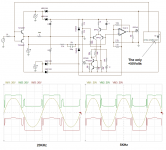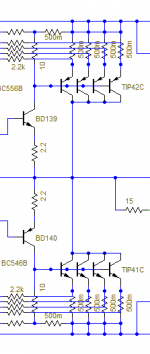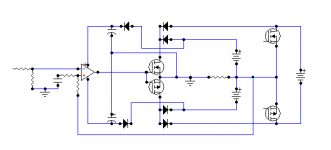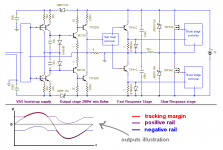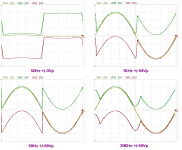Its not complex IMHO,
Under normal conditions the +/-15VDC is keeping the bjt amplifier into quiescent conditions and for large swings the floating mono battery just swaps its position to required polarity in order to juice up more voltage with respect to ground via mosfet switches and schottky diodes combination.😀
To make it more interesting one can use grounded collector or emitter with floating rails to overcome the need for high voltage preamp/vas stage.
No one replied yet, i am the first one to reply..........😉
Under normal conditions the +/-15VDC is keeping the bjt amplifier into quiescent conditions and for large swings the floating mono battery just swaps its position to required polarity in order to juice up more voltage with respect to ground via mosfet switches and schottky diodes combination.😀
To make it more interesting one can use grounded collector or emitter with floating rails to overcome the need for high voltage preamp/vas stage.
No one replied yet, i am the first one to reply..........😉
Last edited:
Thanks for first reply,
Yes interesting, a current mirror like (see attachement).
Another interesting here: Their amplifier stages are simple, 9 transistors (8 without bias) for 600W into 12ohm, only 1pair A1943 C5200. No joke , it is real. They are mass produced.
I am now searching other than mackie that apply this to their amps, but no result this far😀
Yes interesting, a current mirror like (see attachement).
Another interesting here: Their amplifier stages are simple, 9 transistors (8 without bias) for 600W into 12ohm, only 1pair A1943 C5200. No joke , it is real. They are mass produced.
I am now searching other than mackie that apply this to their amps, but no result this far😀
Attachments
Thanks for first reply,
Yes interesting, a current mirror like (see attachement).
Another interesting here: Their amplifier stages are simple, 9 transistors (8 without bias) for 600W into 12ohm, only 1pair A1943 C5200. No joke , it is real. They are mass produced.
I am now searching other than mackie that apply this to their amps, but no result this far😀
I think i can make a similar use of this topology in Mosfet grounded source configuration for Class-A on +/-20V and just one Floating High Voltage source to get more swing.
Attachments
Thanks for first reply,
Yes interesting, a current mirror like (see attachement).
Another interesting here: Their amplifier stages are simple, 9 transistors (8 without bias) for 600W into 12ohm, only 1pair A1943 C5200. No joke , it is real. They are mass produced.
I am now searching other than mackie that apply this to their amps, but no result this far😀
ontoaba, Are you wanting to diy a subwoofer? I'm thinking you could hurt
yourself seriously without the proper understanding and knowledge of the
fundamentals of electronics.
600W into 12ohm ( PMPO perhaps?) with only 1 pair of 2SA1943,2SC5200 no joke?
It is A JOKE 😱That's B&S and misrepresentation. In commercial amps these 1 pair will only be 50W max. and it's pushing them really but the manufactuter knows you won't go there because long before this level your ears will bleed!😀
Use your common sense and I'm sure if you really examine
these high power amps even a modest one at 100W you need at least
2 pair of transistors per channel.Much less a 600 watter.
If you plan to build an amp and falsely spec your amp as a 600W
for example,you will discover that you have no business and lose
credibility because you are not giving what you promise at the quoted price
which you know in reality can not be done.Just look at a KRELL amp or any
el cheapo one.This is planet earth as far as I know startrek technology has
not reach here.No offence. Regards.
Last edited:
ontoaba, Are you wanting to diy a subwoofer? I'm thinking you could hurt
yourself seriously without the proper understanding and knowledge of the
fundamentals of electronics.
600W into 12ohm ( PMPO perhaps?) with only 1 pair of 2SA1943,2SC5200 no joke?
It is A JOKE 😱That's B&S and misrepresentation. In commercial amps these 1 pair will only be 50W max. and it's pushing them really but the manufactuter knows you won't go there because long before this level your ears will bleed!😀
Use your common sense and I'm sure if you really examine
these high power amps even a modest one at 100W you need at least
2 pair of transistors per channel.Much less a 600 watter.
If you plan to build an amp and falsely spec your amp as a 600W
for example,you will discover that you have no business and lose
credibility because you are not giving what you promise at the quoted price
which you know in reality can not be done.Just look at a KRELL amp or any
el cheapo one.This is planet earth as far as I know startrek technology has
not reach here.No offence. Regards.
Singa,
The amplifier under discussion is not your regular Class-AB like a heat generator Krell.
With a rail tracking or multiple Tier switching getting 600W from just one pair of 5200/1943 is not a JOKE but a reality in itself.
84V rms and 7.5A rms are need for 600WRMS at 12ohms load<<< keep this in mind.
So better you update your Knowledge or remain a joke till your lifetime thinking about Krell and Class-AB amplifiers with so many parallel pairs of transistors to get a punny 300W.
Last edited:
Sorry guys did'nt know this was a switching amp.😱 My appologies.
Too quick on the gun.Class D... (wrong forum?)
Too quick on the gun.Class D... (wrong forum?)
Last edited:
I think i can make a similar use of this topology in Mosfet grounded source configuration for Class-A on +/-20V and just one Floating High Voltage source to get more swing.
Yes, that also working, but all batteries are floating, Mackie is winner 😀 working in classB with tracking rail. Still,, your configuration is better than what I have think before, it is full bridge in my mind for single supply.
Hi singa,
It is not classD, but linear amplifier with tracking rail, it has around 100V(their electrolyt is 160V) single supply converted into variable with buck converter, again only with single IRF640. Their components are very close to tiny amplifiers, but it really has that rating, 600Wrms into 12ohm. Its SWA1501.
See my first post picture. Without buck converter to track the rail, it become classH.
Yes, that also working, but all batteries are floating, Mackie is winner 😀 working in classB with tracking rail. Still,, your configuration is better than what I have think before, it is full bridge in my mind for single supply.
Hi singa,
It is not classD, but linear amplifier with tracking rail, it has around 100V(their electrolyt is 160V) single supply converted into variable with buck converter, again only with single IRF640. Their components are very close to tiny amplifiers, but it really has that rating, 600Wrms into 12ohm. Its SWA1501.
See my first post picture. Without buck converter to track the rail, it become classH.
Hi ontoaba,
A buck converter is used in switching supply but perhaps
not as high frequency as class D any way I understand what you are saying.
Regards.
Yes, that also working, but all batteries are floating, Mackie is winner 😀 working in classB with tracking rail. Still,, your configuration is better than what I have think before, it is full bridge in my mind for single supply.
I think we only need the mono battery + low tier bipolar supply floating for each channel and kick this thing into something powerful.
I think we only need the mono battery + low tier bipolar supply floating for each channel and kick this thing into something powerful.
Hi, Workhorse, your idea are best, look this one, The WON!, Mackie aro no longer win😀.
This will start this way. and it doesn't need that bootstrap if gain only 4x or less. Also another supply could be added at series if needed 100V and more.
This THE WON😱
Attachments
Hi, Workhorse, your idea are best, look this one, The WON!, Mackie aro no longer win😀.
This will start this way. and it doesn't need that bootstrap if gain only 4x or less. Also another supply could be added at series if needed 100V and more.
This THE WON😱
Yeah, it will work this way also..........😉
CE output stage gives you voltage gain also, so no more bootstrapping.😀
This is the first simulation result with linear stage only.
Supply is now 63V diving 8ohm, All BJT using BD139/140 parallel. TIP drop voltages are bad😱.
Better to use mosfets instead......!!!
I would prefer a mono rail step with IGBTS because of almost constant VCE saturation drop at high currents.
Is there any advantage of this single rail switcher thing over the common split rail system ?
I have a feeling that this monorail switching is gonna add more artifacts to the output signal in form of switching noise and extra crossover distortion.
THD will probably be high too, like 1% minimum, if not 10% minimum.
I have a feeling that this monorail switching is gonna add more artifacts to the output signal in form of switching noise and extra crossover distortion.
THD will probably be high too, like 1% minimum, if not 10% minimum.
Is there any advantage of this single rail switcher thing over the common split rail system ?
I have a feeling that this monorail switching is gonna add more artifacts to the output signal in form of switching noise and extra crossover distortion.
THD will probably be high too, like 1% minimum, if not 10% minimum.
Dont Feel,
Explain why you feel that.
But in reality Monorail if used with grounded bridge gives more distortion free output + switching noise is virtually eliminated due to balanced output.
I dont like bridged output for audio amps.
Why?
Do you know benefits of Bridge outputs?
Well bridged outputs makes the amp halves see half the load impedance so if the speaker is 4 ohms like most if not all speakers in sweden are nowdays, the amp halves would see 2 ohms and then you have to make the amp halves 2 ohm stable and this cost you like 4 times the output devices as a ground referenced split rail amp for the same 4 ohm speaker and output power.
The benefits of bridged output is up to 4 times the power for a given rail voltage compared to a ground referenced split rail amp, but it may not sound as good, which is why BTL is nowdays pretty much only used in car audio where output power is the main focus.
So a mono BTL amp would cost as much to build as a stereo ground referenced split rail amp so i'd say price outweights the advantages of bridged output.
just my
The benefits of bridged output is up to 4 times the power for a given rail voltage compared to a ground referenced split rail amp, but it may not sound as good, which is why BTL is nowdays pretty much only used in car audio where output power is the main focus.
So a mono BTL amp would cost as much to build as a stereo ground referenced split rail amp so i'd say price outweights the advantages of bridged output.
just my

Well bridged outputs makes the amp halves see half the load impedance so if the speaker is 4 ohms like most if not all speakers in sweden are nowdays, the amp halves would see 2 ohms and then you have to make the amp halves 2 ohm stable and this cost you like 4 times the output devices as a ground referenced split rail amp for the same 4 ohm speaker and output power.
The benefits of bridged output is up to 4 times the power for a given rail voltage compared to a ground referenced split rail amp, but it may not sound as good, which is why BTL is nowdays pretty much only used in car audio where output power is the main focus.
So a mono BTL amp would cost as much to build as a stereo ground referenced split rail amp so i'd say price outweights the advantages of bridged output.
just my
You forgot some points
Bridge amp uses half the voltage rail of half bridge amps for same output swing, therefore one can use low voltage high current devices which are cheaper than high voltage ones.
Bridge amp makes full use of rails i.e. loading the both rails at same time.
Bridge amp gives double the slewrate of half bridge amp.
my 1 penny
- Status
- Not open for further replies.
- Home
- Amplifiers
- Solid State
- Its only need +50V for +/-45V outputs.
